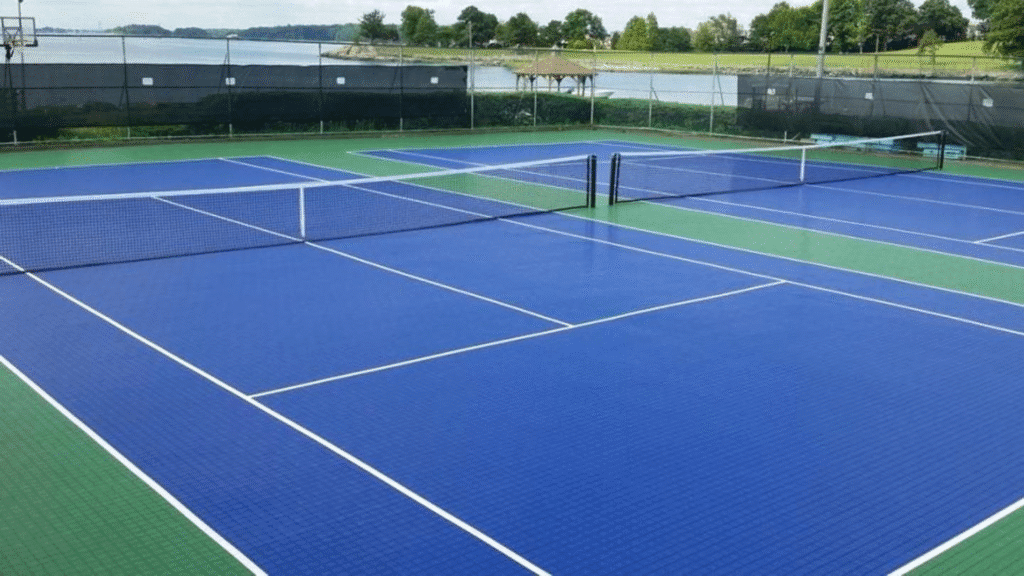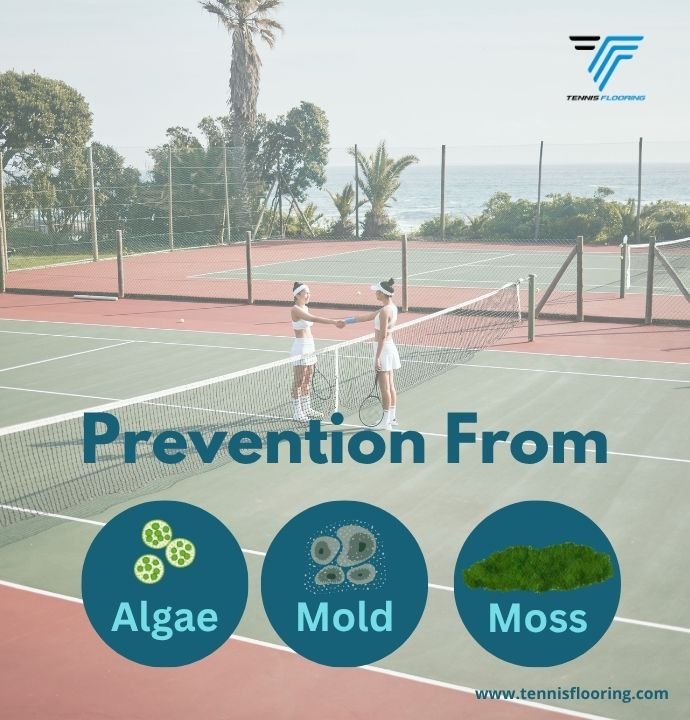How to Maintain Your Tennis Court During Monsoon
Monsoon can be brutal on outdoor sports courts, especially when tennis court maintenance is ignored. Excessive rainwater causes cracks, moss growth, surface fading and structural damage. If regular care is neglected, the playing surface becomes unsafe and ugly and players will go elsewhere.
Table of Contents
In India where rain can pound courts for weeks, maintaining your synthetic surface during monsoon is crucial for performance, safety and aesthetics. This guide will walk you through pre-monsoon preparation, in-season care and post-rain restoration so you can protect your investment and keep play uninterrupted.
1. Tennis Court Size

Before we get into tennis court maintenance, you need to know the space you are protecting. A singles court measures 78 feet by 27 feet, a doubles court 78 feet by 36 feet. Including runoff zones, the total tennis court size in square feet is roughly 7,200 ft².
Knowing these tennis court dimensions helps with drainage, slope calculations and surface protection plans. Accurate measurements ensure rainwater flows away and doesn’t puddle and degrade the acrylic layers.
2. Choosing the Right Surface During Monsoon
Surface choice plays a huge role in monsoon season tennis court maintenance. Clay and natural grass retain water, become slippery and take long to dry. Concrete dries quickly but cracks if unsealed.
Synthetic acrylic tennis court flooring is water resistant, quick drying and easy to clean. The textured topcoat maintains grip even in humid conditions. That’s why Tennis Flooring recommends acrylic systems for outdoor courts in India.
3. Pre-Monsoon Inspection and Repairs
A thorough pre-monsoon inspection is the foundation of good tennis court maintenance. Walk the entire playing area and check for hairline cracks, surface peeling, faded line markings and debris clogging drains.
Fix minor cracks immediately with high quality acrylic patch compounds, especially in high stress areas like baselines and service boxes. Early repairs prevent water from seeping into the base and causing larger structural problems
4. Drainage and Slope: The Unseen Guardians
Drainage is the key to long term tennis court maintenance success. Courts should be sloped about 1%—roughly 1 inch every 10 feet—so water runs off quickly. Check side drains and outlet pipes for blockages before the first storm hits.
If water pools, call professional resurfacing companies to regrade or install additional trench drains. Good drainage means lower maintenance costs and safer play sooner after rain.
5. Cleaning During the Rainy Season
Daily cleaning is non negotiable during monsoon tennis court maintenance. Leaves, twigs and silt collect fast, clog drains and algae grows. Use a soft broom or blower every morning to remove debris and keep water flowing.
For deeper cleaning sessions use a pressure washer set below 1,200 PSI and avoid harsh chemicals that can strip acrylic coatings. Regular washing keeps traction and protects vibrant tennis court colors from permanent staining.
6. Algae, Mold and Moss Growth Prevention

India’s monsoon humidity accelerates fungal growth. Monthly treatment with non toxic algaecide or a mild bleach solution diluted in water is essential for proactive tennis court maintenance.
Avoid abrasive brushes that damage tennis court surface texture. Regular treatments prevent discoloration, maintain grip and push resurfacing cycles further away.
7. Equipment Protection During Rain
Nets, posts and light poles corrode if forgotten in your tennis court maintenance plan. Apply marine grade anti rust coatings to hardware, tighten loose fasteners and store rollers, squeegees and blowers in a dry shed.
Covered benches and windbreaks also reduce debris spread, improves visibility and reduces cleanup time during heavy showers.
8. Daily Maintenance During Rain
After every rain, do a quick yet thorough tennis court maintenance. Use a court squeegee to remove standing water, then let sunlight or blower fans dry. Check baselines and service boxes—areas that get the most foot traffic—for moisture pockets or scuff marks.
Post real time updates on social media about court status. Players searching “tennis court near me” will appreciate up to date information even on rainy days.
9. Post Storm Recovery and Emergency Action
Heavy storms can bring branches, mud and even small stones on the surface. First clear all debris without dragging sharp objects across the acrylic topcoat. Then check the court for new cracks or bubbling that needs to be attended in your tennis court maintenance log.
Do not paint or resurface until the base is dry—especially after flooding. Severe damage requires professional evaluation from experienced contractors.
10. When and How to Resurface a Tennis Court
Even the best tennis court maintenance will eventually lead to resurfacing. Signs are persistent slipperiness, extensive color fading and visible cracks that fillers can’t hide.
Resurfacing involves deep cleaning, crack filling, multiple layers of resurfacer and color coats and precise re-marking of playing lines. Always engage licensed contractors to get a durable and high performance finish.
11. Upgrade Your Court: Design and Features
Monsoon downtime is a great opportunity to upgrade your facility. Consider new color schemes, branded logos or overlaid pickleball lines for multi sport flexibility are all part of forward thinking tennis court maintenance.
Upgrade to waterproof LED lighting and install moisture sensors that alert staff when conditions are not safe. Smart features increase player satisfaction and search visibility.
12. Long Term Cost Efficiency and ROI
While proactive care may seem expensive, strategic tennis court maintenance protects your investment and extends the life of the tennis court surface by years. Well maintained courts attract more bookings, command higher rental fees and reduce expensive emergency repairs and deliver a stronger ROI over time.
13. Choose the Right Partner for the Job
A good tennis court maintenance starts with the right experts. Tennis Flooring —India’s leading manufacturer of outdoor sports flooring—offers end to end solutions from new acrylic systems to complete resurfacing and seasonal maintenance. Whether it is a school, club or residential complex, our experts build and maintain courts that can withstand the toughest monsoon.
Conclusion
Monsoon doesn’t have to ruin your game or your budget. With regular maintenance, good quality materials and professional support your court can be safe, vibrant and match ready all year round. Invest in preventative care by knowing your court dimensions, clear the drainage and schedule repairs. Partner with Tennis Flooring for advice and products and you’ll turn heavy rain into just another day of play.
Whether you’re managing a school, club or residential facility, proactive court maintenance means uninterrupted play and long term savings. Don’t wait for damage to happen by acting early with weather resistant flooring, scheduled inspections and expert servicing. With Tennis Flooring as your partner your outdoor court will play beautifully.
Monsoon maintenance prevents surface damage, crack expansion, moss growth and player injuries. It also extends the life of your tennis court surface and keeps the court safe, functional and looking good during wet weather.
Use a court broom or blower to remove leaves, dirt and debris daily. After rain, use a squeegee to remove standing water immediately. Pressure wash the court periodically to prevent algae and moss buildup, to maintain traction and court color.
A tennis court should have a slope of about 1%, or 1 inch per 10 feet, to ensure good water drainage. This slope prevents water accumulation and minimizes the risk of surface damage or player injury during monsoon.
Tennis court resurfacing includes cleaning the court, repairing cracks or low spots, applying new acrylic surface layers and repainting tennis court lines. Hiring professional contractors ensures a durable result.
Apply anti-rust spray to all metal fixtures like net posts and fence hardware. Store court maintenance tools – squeegees, rollers, blowers in dry, covered areas to prevent corrosion, mildew and wear during humid weather.
